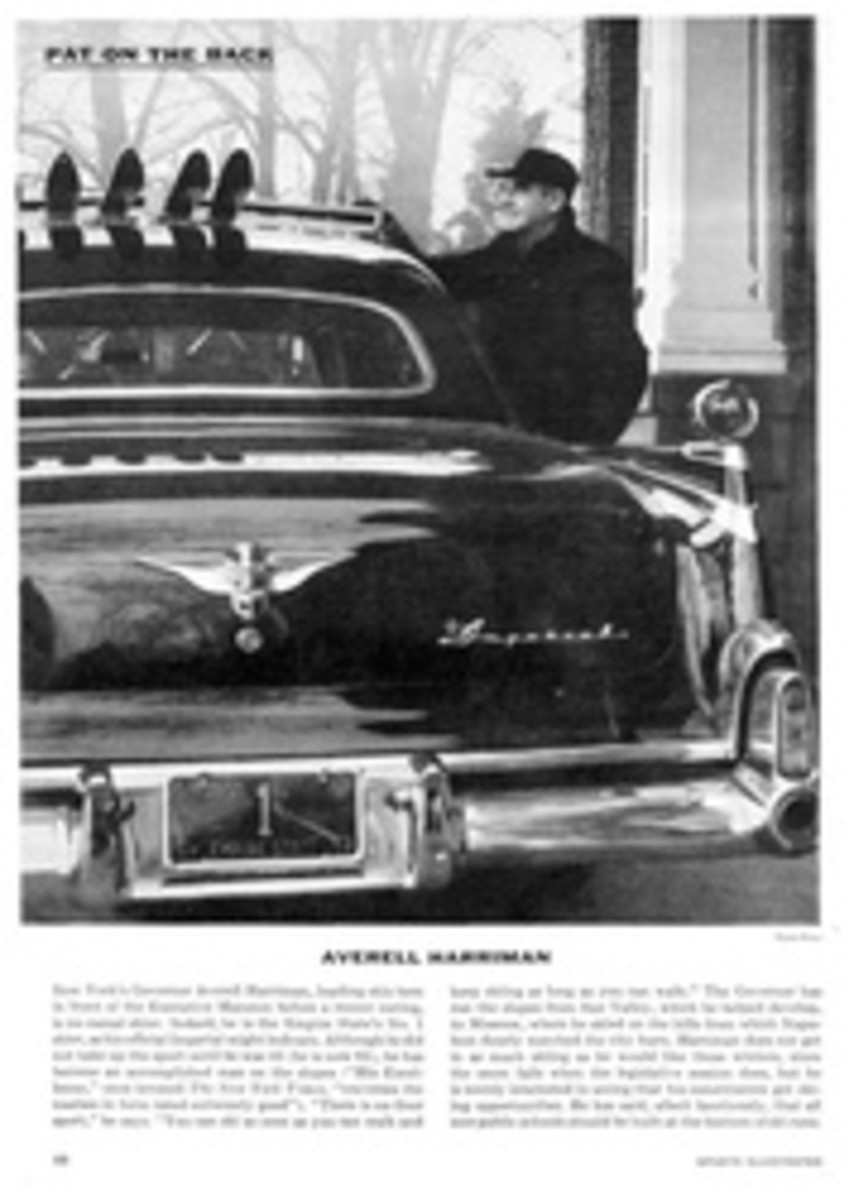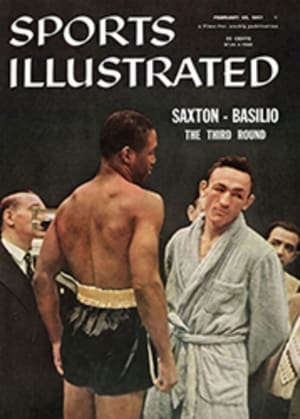
SKIING'S CLASSIC GROUNDS
Deep in the Alps between Zurich on the west and Innsbruck on the east there is a small chink in the great wall of Europe through which the journeyer can filter from Switzerland into Austria, indeed from the Channel to the Balkans. It is called the Arlberg Pass, a narrow niche four-fifths of a mile high. Tourists can cross it by-car, and trains can run its tunnel, especially the Arlberg-Orient Express, which careens through daily en route from Paris to Bucharest, carrying its legendary complement of diplomats, demimondaines and derring-doers.
But more important to many is the fact that on the slopes of the Arlberg Pass Austrian mountain men, led by the late Hannes Schneider, took the Norwegian art of skiing cross-country, adapted it for easy downhill running and made it, in time, a sport for every-man. This year, as the Arlberg celebrates the 50th anniversary of Schneider's first ski school, and therefore of the Arlberg technique, the slopes of the mountain pass are crowded with men of all nations who have flocked to its birthplace to pursue the white sport. Day on sunny day Frenchmen and Germans, Americans and Belgians, and Englishmen by the score crowd the Austrian inns to sip Branntwein and beer, fatten on Rindsgulyas mit Salzkartoffeln and whipped-cream-crested pastry and listen to the plaintive pluckings of the zither. But above all, they ride the lifts and the tows and go whizzing down the incomparable Alpine sides where 50 years ago it all began.
St. Anton takes its sport seriously, Zürs is fashionable and Lech, which has grown so in the last 10 years, seems to be for everyone. Ski lessons in the Arlberg technique first began in 1907 when the Schuler family, who owned the Hotel Post, a popular summer place, imported Hannes Schneider from Stuben 10 kilometers over the hills and told him to open a ski school that would attract winter customers. Hannes taught the Austrian mountain troops in the first war, went to Japan in 1930, and in 1936, with Benno Rybizka and Otto Lang, he came to the U.S. to ski on shaved ice spread over a make-do slope set up in Madison Square Garden and in the Boston Garden. Out of favor with the Nazis, Hannes brought his family to the States and subsequently took over the ski schools at Jackson and North Conway (where his son Herbert is now the mentor).
In 1935, the year before he went to the States, Schneider's St. Anton ski school employed 30 teachers. During the Christmas rush this year Rudi Matt, who ran the house and shop during Schneider's time in the U.S. and who is now head of the school, had a company of 80 multilingual instructors on the slopes. (Matt ran the Sun Valley ski school in 1950-51.)
Meanwhile the Hotel Post, which had, by most historical interpretations, started it all to promote winter business, was still being run by the Schulers. By all odds it is the largest, most soigné hotel in St. Anton. The Dutch royal family descends each year after Christmas, stays until mid-January. Pictures on the wall record the presence of the Averell Harrimans and Claudette Colbert. Its 82 rooms (half of them with bath) rent for about $9 a day per person including meals and all extras. Most luxurious of all is a three-room suite which Millionaire C. V. Starr of New York, an early booster of Stowe, Vt., paid to have furnished with pine paneling, oil paintings and wall-to-wall carpeting. The Starr chamber is available when Starr is out of town.
A delightful inn which fairly exudes a romantic, there's-a-small-hotel quality is the Mooserkreuz, a few minutes from the village. Run with faultless taste by Franz Opitz, once the manager of Vienna's Sacher, it is outside the steep canyon walls of the village and its balconies face the full flood of the sun. About $7.50 a day—room, bath, meals, tips and taxes.
Cheaper still is the remodeled 60-room Hotel Arlberg, which charges between $5.50 and $6.50 a day. The dining room looks out on the ice pond, and at night a two-man band (one virtuoso plays the drum and trumpet simultaneously) draws the young, baggy-sweater set who dance until the earlier hours.
For those who don't want to cart them from home, skis rent for 50¢ a day, ski boots for 40¢, and in a number of ateliers about town tailors will make up ski pants to measure in about 12 hours at anywhere from $20 to $40. The biggest shop in St. Anton, called the Sporthaus Hannes Schneider, is run by Hannes' daughter Herta, who came home in 1954 to marry Franz Fahrner, a ski instructor. They offer Kneissl and K√§stle skis at about half the U.S. price and Walch and Strolz boots (the Strolz factory is in Lech) for $30. Altmann's Vienna cashmere sweaters are about $14, and a cottage industry turns out heavy sweaters in patterns copied from the Norwegian. The Fahrners can also take 16 guests in spotless rooms over the shop which rent for $2.20 a day, including breakfast, heat and tax.
Perhaps the best shopping of all is in Lech, a half hour's drive over the mountain roads. Ambros Strolz offers a variety of high-styled sweaters and parkas, but in the back of the shop 23 men and three girls turn out 4,000 pairs of Strolz boots a year, each of them made completely by hand by one person. Some 70% of the Olympic racers of all nationalities wore Strolz boots during the last competition. The cost is $30 even if you buy at the factory, but you can have them handmade to measure in about three days.
Down the street at Pfefferkorn's, a modern shop run by the mayor, Austrian daytime dirndl dresses by Lanz of Salzburg are $12, silk and brocade evening dirndls about double. Norwegian-type sweaters at $8 are cheaper than the originals.
Next door, the Tannbergerhof, one of the eight hotels (plus 16 pensions) of Lech, was redone in 1953 with Marshall aid, now has 60 rooms, 14 of them with private bath. The rate with the plumbing is about $8 a day, and that includes afternoon tea, a ritual in the Arlberg, In the evenings there is an occasional Vienna night, with songs by candlelight, Schrammelmusik from the accordion, violin, guitar and zither, and wine poured from a bottle turned upside down in a bracket.
The Gasthof Post is really not a Gasthaus but a full-fledged hotel embossed on the outside with flaring frescoes full of Gemütlichkeit and sauerkraut and on the inside with chamois furs, skins of mountain sheep, stuffed birds, pistols, horns and breakfronts that date from the 16th century. There are 30 rooms in all, 11 with bath, including No. 20, occupied for a long time, before her death in 1951, by Ludwig Bemelmans' mother. A photograph on the wall shows Bemelmans during a visit lighting mother's cigar. He also found time to paint the bathroom walls with scenes of Regensburg where he grew up, Paris where he lived, and the Statue of Liberty which he adopted. Room and meals at the Post are $7.80 a day, but if you want Zimmer No. 20 it costs $1.60 a day extra, whether you look at the murals or not.
Besides its hotels, Lech and Oberlech have 20 pensions scattered at altitudes ranging from 4,746 to 5,190 feet. During the month of January and from March 23rd until April 18th the rates are as low as $2.40 a day for a room and three meals and down to $1.36 per person for bed and breakfast. Rooms in private homes can be had for one U.S. dollar with breakfast.
In mid-February, guests in Lech for the winter send to Witte's costume house in Vienna for costumes to wear at the annual fancy dress ball on skis staged at the end of February each year. Some, of course, make their own. On carnival day (this year: February 27), the renters and the manufacturers don their garb and follow the country band on a parade from one end of Lech clear to the other, a distance of about a kilometer. After that they climb a hill and ski past the judges. The prizes are cakes and wine donated by the village, and that night there are costume dances all over town.
The party seems to run all season long down the road at Zürs, a gay little nest of half a dozen or so hotels snuggled between two broad, open, rolling, treeless slopes. Loungers sit on tall stools at the open-air bars, learners skim the nursery slopes under the tutelage of Friedrich Schneider, younger brother of Hannes, and the schussers rest against the T bars for the ride between the hotels, past the tall spire of the modern church, up, up into the white.
Perhaps the handsomest hotel in the Arlberg is the Zürserhof, first built as a private residence by a German count who later made it into an elegant boarding house so he could have some company. He left for Costa Rica after the Anschluss of 1938 and the house has since passed into the hands of Ernst Skardarassi, once a waiter at the Waldorf in New York. It is still filled with brass fittings, silk draperies, chintz and linen walls, parquet floors, oils from Holland, prints from China. Guests may appear in the graceful sun-filled dining room in almost any sort of sport garb by day and after lunch recline in the deep chairs on the terrace for a midwinter tan. But on nights when the Zürserhof holds a candlelit dinner dance one is expected to appear in a dinner jacket or at least a dark suit.
Americans flock to the Lorünser, whose manager, Herbert Jochum, once of Sun Valley, coached the U.S. girls' team in the ski events of the Oslo Olympics. The Flexen is small, homey, fun and unpretentious and, although there are few private baths, there is a big porch right alongside the slopes where guests can take the southern sun wrapped up in fur rugs, in steamer chairs, all for as little as $6 a day.
Before the war, visitors arriving at the Langen railway station had to make their way to Zürs by horse-drawn sleigh. Now there is a road covered with galleries to protect the traveler from avalanches, and when the holiday is done the little red hotel buses take the skiers down to the rail line that leads to Zurich, and from there it is only a leap to London and New York. Aboard the train pile the English families with their masses of children. And the kids snag empty seats and shout after their fathers, "Deddeh, deddeh, this one's not bagged." Then the train chugs westward from the Arlberg. Down in the valley the sleigh bells tinkle, the cowbells clank, and a hotel porter in a green felt apron clambers along the snow-banked roads in pursuit of a mission. But out the window as the train rolls back to Urbania all you can see are 10,000 Christmas trees like spearheads dusted white, every one pointed straight up to the azure cloudless sky.
PHOTO
SCHNEIDER'S DAUGHTER, Herta Fahrner, runs sports shop, St. Anton's largest.
PHOTO
SCHNEIDER'S HEIR, Rudi Matt, chats with St. Anton veteran at the Schneider ski school. Once Sun Valley's teacher, Matt now heads Schneider school, a booming proposition.

